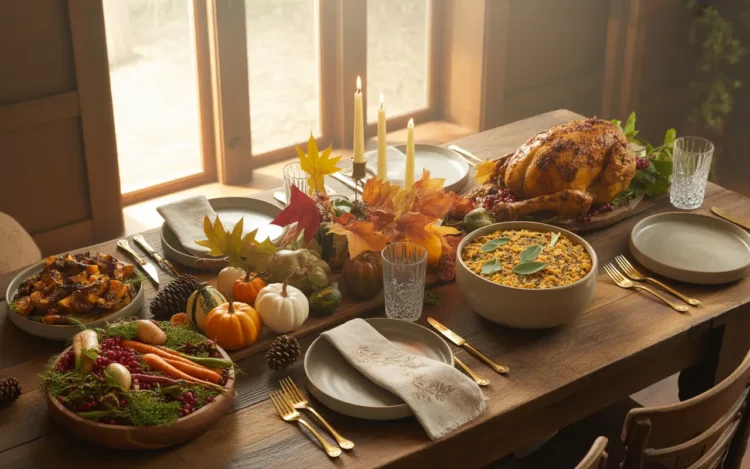Key Takeaways
- Reduce food waste by planning portions carefully and creatively using leftovers
- Choose seasonal, local ingredients for a lower carbon footprint
- Create stunning eco-friendly decorations from natural materials
- Use reusable dishware and sustainable serving options
- Incorporate more plant-forward dishes like cheesy kale stuffing
- Consider energy-efficient cooking methods for your feast
- Support local producers and ethical farming practices
- Engage guests in sustainable activities to create lasting memories
- Document your sustainable practices to create new family traditions
- Share the environmental impact of your choices to inspire others
The Evolution of Thanksgiving: From Traditional to Sustainable
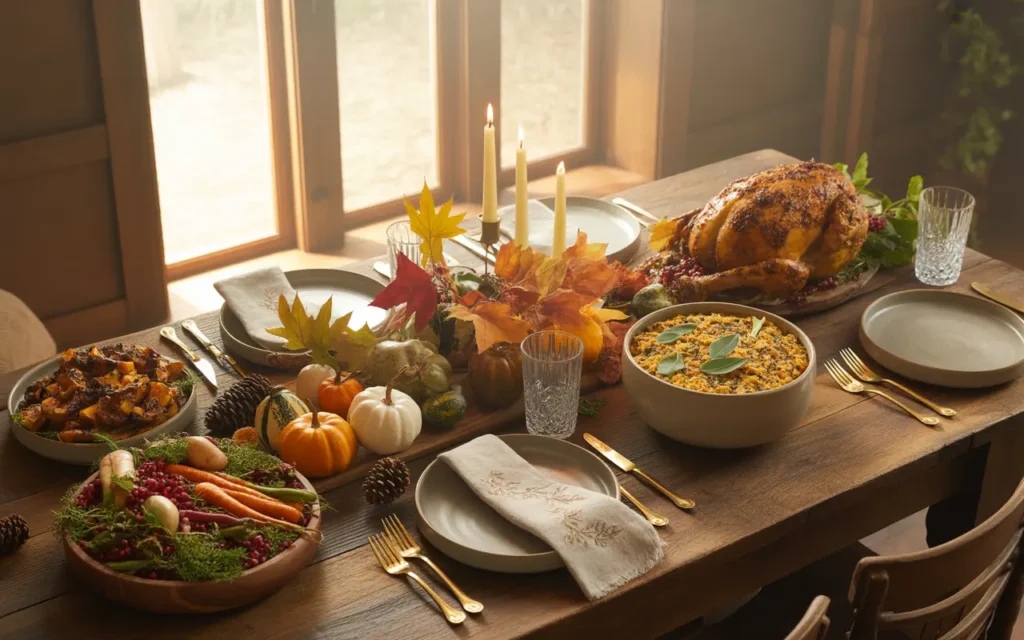
Thanksgiving has evolved significantly since its origins, transforming from a simple harvest celebration to one of America’s most beloved holidays. Today, as environmental consciousness grows, many families are reimagining this feast with sustainability in mind. This shift doesn’t mean abandoning cherished traditions but rather enhancing them with practices that honor both our cultural heritage and our planet. By incorporating eco-friendly approaches, families are discovering that sustainable celebrations often feel more authentic and connected to the original spirit of gratitude and abundance that defines Thanksgiving.
The modern sustainable Thanksgiving movement began gaining momentum in the early 2000s, as awareness about climate change and environmental issues became more mainstream. What started as simple steps like recycling dinner packaging has blossomed into a comprehensive approach to celebrating mindfully. Did you know that Americans throw out approximately 25% more trash between Thanksgiving and New Year’s Day compared to other times of the year? Each Thanksgiving, we discard an estimated 200 million pounds of turkey meat alone! These staggering statistics have motivated many families to reconsider how they approach this holiday, leading to innovative practices that reduce waste while enhancing the celebration experience. Environmental experts point out that holiday waste contributes significantly to landfill problems, with food waste generating methane—a greenhouse gas 25 times more potent than carbon dioxide.
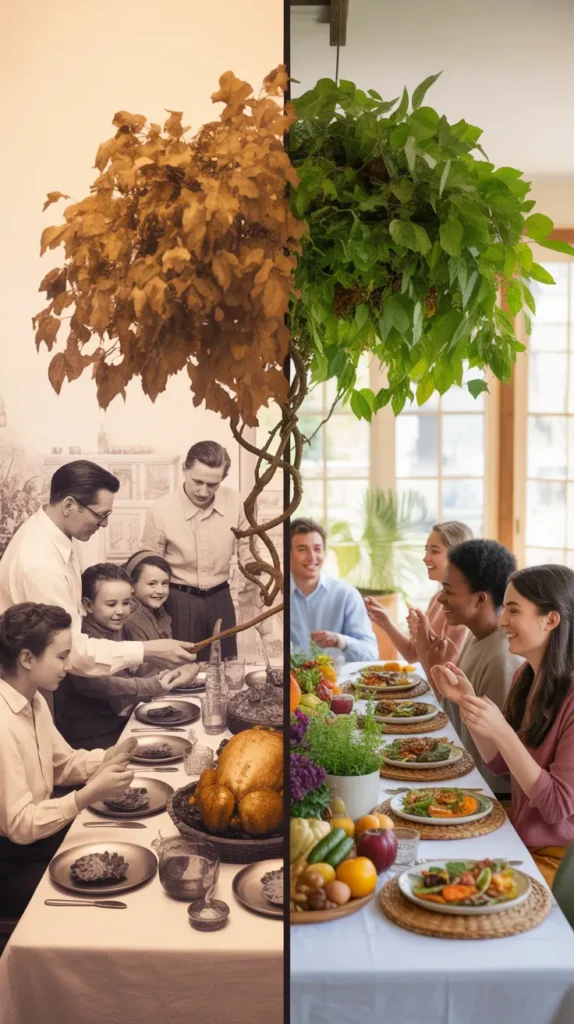
The beauty of sustainable Thanksgiving practices lies in their ability to create memorable experiences that feel even more special and intentional. By connecting our celebration to seasonal rhythms and local bounty, we tap into the original spirit of Thanksgiving while creating new traditions that future generations can proudly carry forward. Plus, these practices can actually save you money and reduce stress by helping you plan more efficiently! Many families report that their sustainable celebrations feel more meaningful and less commercially driven, allowing them to focus on what truly matters: gratitude, connection, and creating lasting memories with loved ones. Sustainable approaches also often result in healthier, more flavorful meals since they emphasize fresh, seasonal ingredients at their peak.
Our comprehensive Thanksgiving recipe collection offers numerous options for creating a feast that’s both delicious and environmentally conscious. From appetizers to desserts, we’ve curated recipes that emphasize seasonal ingredients and minimize waste. These recipes have been developed with sustainability in mind, focusing on whole foods that can be sourced locally when possible and prepared with minimal environmental impact.
Mindful Menu Planning: The Foundation of a Sustainable Feast
The heart of a sustainable Thanksgiving begins with thoughtful menu planning. This crucial first step helps prevent food waste while ensuring your celebration remains abundant and satisfying. Begin by taking an accurate headcount and planning realistic portion sizes for each guest. Remember when you were a kid and your eyes were bigger than your stomach? The same thing happens with Thanksgiving planning – we tend to overestimate how much food people will actually eat! Professional caterers typically calculate about 1-1.5 pounds of food per person for a holiday meal, which is far less than most home cooks prepare. By planning your menu with these professional guidelines in mind, you can create a feast that feels abundant without generating excessive waste.
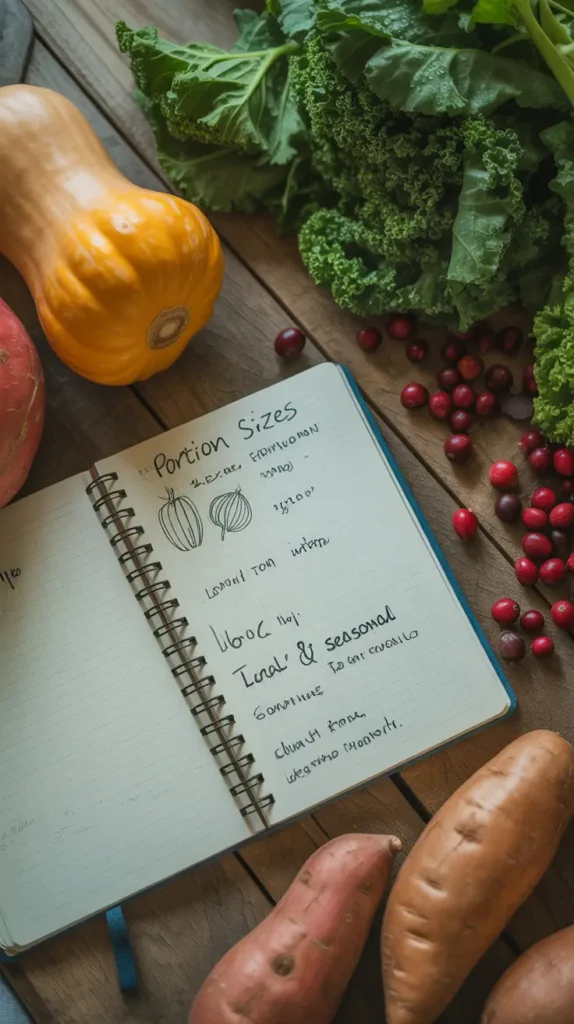
When designing your menu, consider these sustainable approaches:
First, prioritize plant-forward dishes. Vegetables typically have a lower environmental footprint than animal products. Try making vegetables the star of several dishes rather than merely sides. Did you know that potatoes have approximately one-tenth the greenhouse gas emissions of poultry on a per-calorie basis? That’s a pretty good reason to pile your plate with extra mashed potatoes! According to environmental nutrition experts, shifting even one or two dishes from meat-centered to plant-based can reduce your meal’s carbon footprint by up to 30%. This doesn’t mean eliminating traditional favorites like turkey, but rather balancing them with abundant plant options that everyone will enjoy.
Second, choose seasonal ingredients. Foods in season require fewer resources to grow and transport. For November, think squashes, sweet potatoes, cranberries, apples, and hearty greens like kale. These foods not only have a lower carbon footprint but they also taste better because they’re at their peak freshness. Agricultural scientists explain that seasonal produce typically contains more nutrients and flavor compounds than out-of-season alternatives that may have been stored for months or grown in artificial conditions. By building your menu around what’s naturally available in your region during fall, you create a feast that connects to the original harvest celebration spirit of Thanksgiving.
Our Spectacular Thanksgiving Cheesy Winter Green Stuffing with Kale exemplifies sustainable menu planning. This recipe transforms humble kale into a memorable side dish that might just outshine the turkey! Culinary experts note that incorporating winter greens into traditional recipes adds nutritional value while introducing exciting flavor dimensions that can make your feast more interesting and satisfying for guests of all dietary preferences.
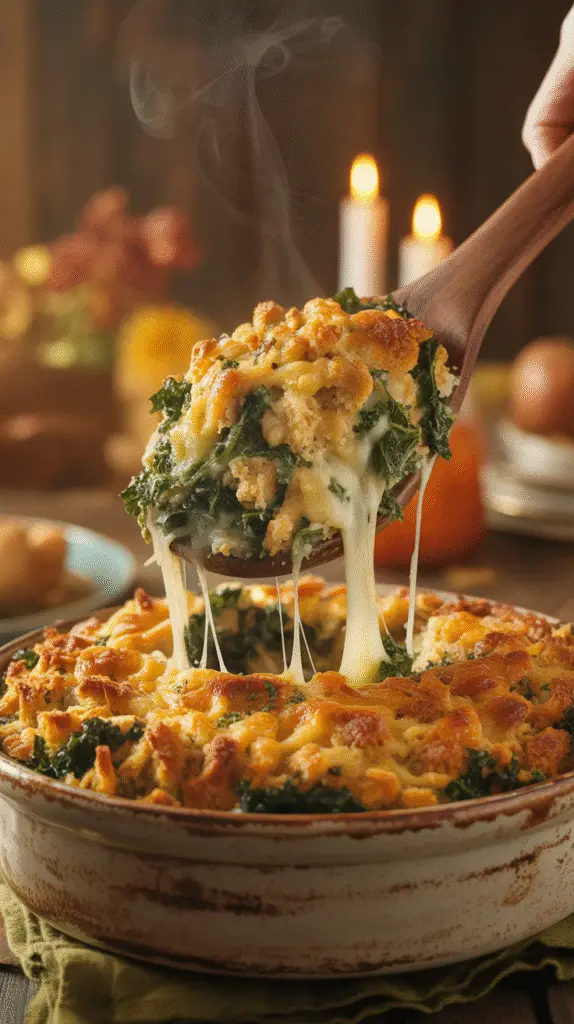
This stuffing isn’t just delicious—it’s also a sustainable choice that incorporates seasonal winter greens, reduces the need for meat-heavy options, and creates a memorable centerpiece that guests will talk about for years to come. Plus, it uses leftover bread, helping to reduce food waste before you even start cooking! Nutrition experts appreciate that this dish provides significant amounts of vitamins K, A, and C, along with calcium and fiber, making it a nutritional powerhouse compared to traditional stuffing recipes. The combination of hearty greens with comforting cheese and bread creates a satisfying texture and flavor profile that appeals to both vegetarians and meat-eaters alike.
Sustainable Menu Planning Benefits
🌱 Environmental Impact
Reduced carbon footprint from transportation and production
💰 Economic Benefits
Lower costs from seasonal produce and reduced waste
❤️Health Advantages
Fresh, seasonal foods offer optimal nutrition and flavor
Vegetarian Appetizers: Starting Your Meal Sustainably
Setting the stage for your sustainable Thanksgiving begins with thoughtfully crafted appetizers. Plant-based starters not only reduce your meal’s environmental footprint but also create a memorable beginning to your celebration that leaves guests eagerly anticipating what comes next. Think about it – have you ever been to a Thanksgiving where you were already stuffed before the turkey even arrived? Starting with lighter, vegetable-based appetizers helps prevent that food coma before the main event! Nutritionists recommend beginning holiday meals with produce-rich options to ensure guests receive essential nutrients even if they fill up before trying everything on the table. This approach also helps moderate appetite, potentially reducing overall consumption and waste.
Our collection of stunning vegetarian appetizer recipes offers perfect options for your sustainable Thanksgiving gathering. Consider these memorable starters:
Caprese Skewers with Balsamic Drizzle are super easy to make and showcase the red and green colors of the season while offering a light beginning that won’t fill guests before the main event. Kids love them because they’re fun to eat, and adults appreciate their simplicity and fresh flavors. Plus, they require zero cooking, saving energy! Food scientists note that the combination of acid from tomatoes and balsamic with fat from cheese creates a perfectly balanced flavor profile that stimulates the palate without overwhelming it. This makes these skewers an ideal first bite that prepares the taste buds for the complex flavors to come in your main meal.
Spinach and Artichoke Stuffed Mushrooms utilize hearty mushrooms as vessels for creamy filling, creating a substantial appetizer with minimal environmental impact. Did you know mushrooms are one of the most sustainable foods? They can be grown on agricultural by-products and require very little water and space compared to other foods. They’re like the superheroes of sustainable ingredients! Mycologists (mushroom scientists) explain that mushroom cultivation can actually help break down waste products from other agricultural processes, making them a circular economy food. Additionally, their meaty texture and umami flavor profile make them particularly satisfying for guests who might be missing meat-heavy options.
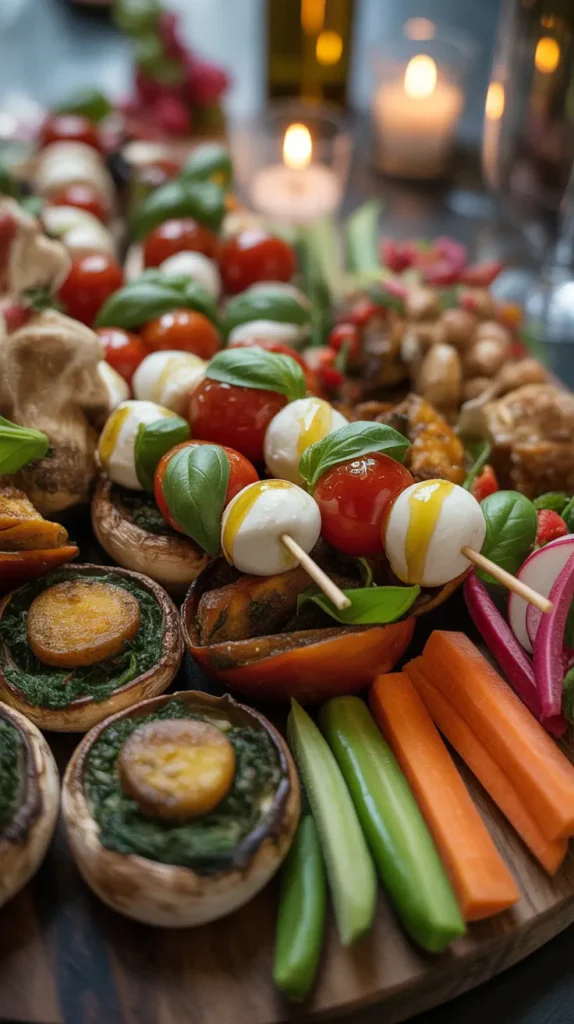
When creating your appetizer spread, consider these sustainable practices:
Serve room temperature items to reduce energy usage by offering starters that don’t require heating or refrigeration during serving. Use local, seasonal produce by incorporating fall vegetables like sweet potatoes, winter squash, and Brussels sprouts. And choose reusable serving ware – opt for ceramic platters, wooden boards, or glass dishes instead of disposable options that end up in the trash before the meal even begins. Event planning professionals recommend creating a visual “flow” with your appetizer display, arranging items from lightest to most substantial, which not only creates an attractive presentation but also naturally guides guests toward moderate consumption patterns.
Our Thanksgiving appetizer strategy guide provides additional tips for creating a memorable and sustainable start to your feast, with emphasis on preparation timing and complementary flavors. Following expert advice on appetizer timing can significantly reduce food waste while enhancing your guests’ overall dining experience.
Sustainable Sourcing: Choosing Ingredients with Purpose
The ingredients you select for your Thanksgiving feast represent perhaps your most significant opportunity to reduce environmental impact. Thoughtful sourcing creates a memorable meal with stories behind each component, connecting your table to local farmers and seasonal rhythms. Remember when food didn’t come from anonymous factories but from people and places we knew? Sustainable sourcing helps recapture that connection. Food anthropologists note that traditional harvest celebrations around the world share this common element of connection to specific local foods and the people who produce them. By prioritizing sustainable sourcing, you’re actually returning Thanksgiving to its authentic roots as a celebration of local abundance.
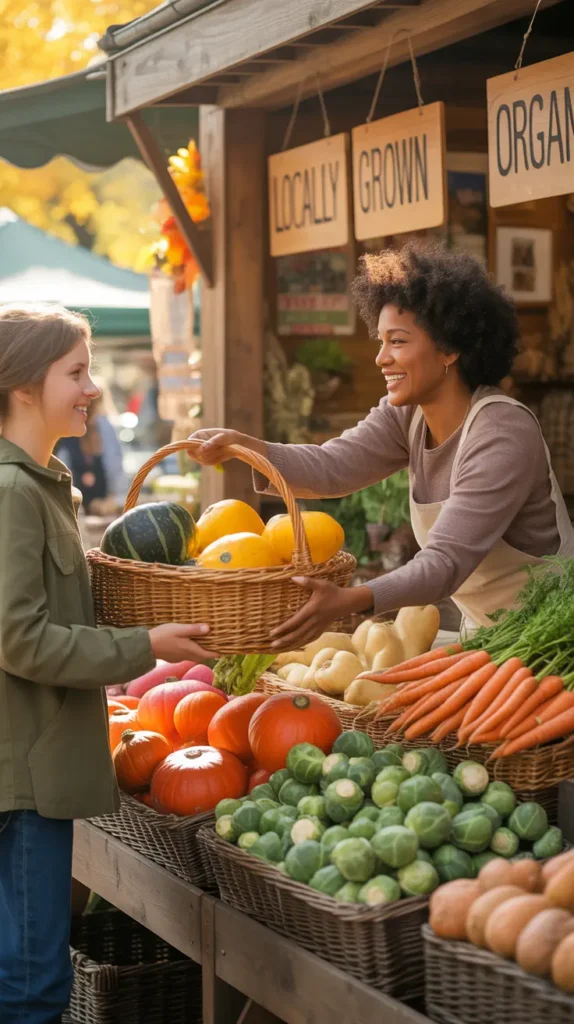
When sourcing your Thanksgiving ingredients, focus on local and seasonal produce. Fruits and vegetables grown locally and in season typically require fewer resources to produce and transport. For November in most parts of the United States, look for winter squashes (butternut, acorn, delicata), root vegetables (sweet potatoes, carrots, parsnips), hearty greens (kale, collards, Brussels sprouts), late-season apples and pears, and cranberries. Agricultural economists estimate that the average American meal travels about 1,500 miles from farm to plate. By sourcing locally, you can reduce this distance dramatically, cutting transportation emissions while supporting regional food systems that preserve agricultural diversity and resilience.
Benefits of Local, Seasonal Ingredients
Local, Seasonal Ingredients
Environmental Impact
Reduced transportation emissions
Lower energy for storage
Less packaging waste
Flavor Quality
Peak ripeness
Optimal nutrient content
Distinctive seasonal character
Community Benefits
Support for local farmers
Preservation of agricultural land
Regional food security
If your Thanksgiving traditions include turkey or other animal proteins, consider more sustainable options. Look for heritage breed turkeys raised on pasture, locally raised, humanely certified poultry, or consider smaller portions of high-quality meat paired with abundant plant-based sides. Did you know that the average turkey raised for meat weighed 17 pounds in 1970 but averages 28 pounds today? Modern turkeys have been bred to grow so large that their legs often break beneath them – not exactly the kind of farming practices most of us want to support! Sustainable agriculture experts explain that heritage breed turkeys grow more slowly and naturally, resulting in better flavor and texture while allowing the birds to express natural behaviors throughout their lives. These birds typically cost more but provide superior taste and align with ethical values that many families find worth the investment for special occasions.
Supporting sustainable producers means looking for ingredients with meaningful certifications that align with your values. These might include organic certification (reduced pesticide use), Fair Trade (ethical labor practices), regenerative agriculture (soil health and carbon sequestration), or B Corp certification (overall social and environmental responsibility). Food policy experts recommend becoming familiar with the standards behind various certifications to ensure they align with your personal priorities, as some labels are more meaningful than others. For example, “natural” has no regulated definition on food packaging, while “USDA Organic” represents specific, verified production practices.
Our cheesy winter green stuffing exemplifies sustainable sourcing by featuring seasonal kale as its star ingredient. With just 300 calories per serving and packed with nutrients, this dish demonstrates how sustainable choices can be both delicious and nutritious. Nutritional analysis shows that this recipe provides over 100% of your daily vitamin K needs and significant amounts of vitamins A and C, making it not just environmentally sound but also a health-promoting addition to your holiday table.
Creative Leftover Strategies: Extending the Feast Sustainably
Perhaps the most memorable aspect of Thanksgiving isn’t just the day itself but the delicious meals that follow. A truly sustainable approach embraces leftovers as an opportunity rather than an afterthought. With thoughtful planning, your Thanksgiving bounty can provide nourishing, creative meals for days afterward. Remember how exciting it was as a kid to make a giant sandwich with all the Thanksgiving goodies the next day? That same creativity can be applied to all your leftovers! Food waste reduction specialists point out that planning for leftovers actually represents a higher form of sustainability than simply avoiding excess, as it acknowledges the reality of holiday abundance while ensuring nothing goes to waste.
Before your Thanksgiving meal even begins, consider these strategies: Prepare storage containers by having clean, reusable containers ready for efficient packing of leftovers. Create a leftover game plan by knowing which ingredients you’ll transform into new dishes and which you’ll enjoy as repeats of the original meal. And send guests home with care packages by preparing eco-friendly containers that guests can take home, distributing leftovers and preventing waste. Professional chefs recommend labeling containers with contents and dates as you pack them, making it easier to track what needs to be used first and preventing the “mystery container” syndrome that often leads to food being forgotten and eventually discarded.
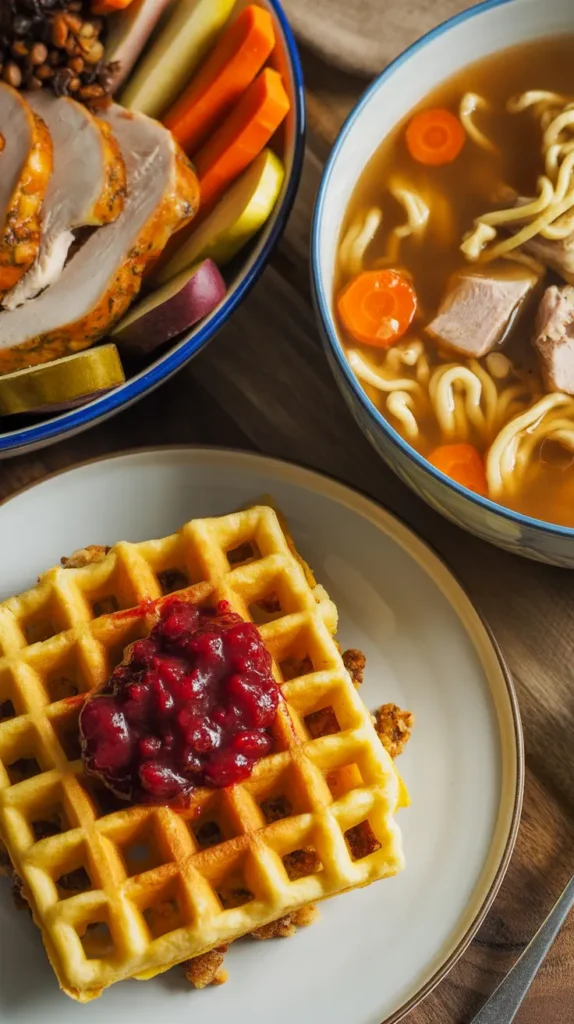
Thanksgiving Leftover Transformation Guide
| Original Dish | Transformation Ideas | Storage Time | Freezable? |
|---|---|---|---|
| Turkey | Sandwiches, soup, pot pie, enchiladas | 3-4 days | Yes |
| Mashed Potatoes | Potato pancakes, shepherd’s pie topping, soup thickener | 3-5 days | Yes |
| Cranberry Sauce | Breakfast topping, sandwich spread, muffin mix-in | 7-10 days | Yes |
| Roasted Vegetables | Frittata, grain bowls, blended into soup | 3-4 days | Yes |
| Bread & Rolls | Bread pudding, croutons, breadcrumbs | 5-7 days | Yes |
| Pie | Breakfast parfait layers, milkshake mix-in | 3-4 days | Some types |
Transform your Thanksgiving components into memorable new meals! Create a Thanksgiving Bowl by layering leftover turkey, vegetables, stuffing, and a small amount of gravy in a bowl for a complete meal. Top with a fresh element like microgreens or a quick-pickled vegetable for brightness. Or try Stuffing Waffles by pressing leftover stuffing (like our cheesy kale stuffing) into a waffle iron for a crispy base that can be topped with turkey and cranberry sauce. Culinary innovation experts note that changing the texture and presentation of leftovers is key to preventing “leftover fatigue” – when family members tire of seeing the same dishes repeatedly. These transformation techniques create entirely new eating experiences using the same ingredients.
Another great option is Turkey Soup – simmer the turkey carcass with vegetable scraps saved during meal prep to create a flavorful broth, then add leftover vegetables and turkey meat for a nourishing soup. Did you know Americans waste around 200 million pounds of turkey during Thanksgiving? By making soup from your turkey carcass, you’re not only creating another delicious meal but also preventing perfectly good food from ending up in a landfill where it produces harmful methane gas. Food scientists explain that bone broth made from poultry carcasses contains valuable nutrients including collagen, minerals, and amino acids that support joint health and immunity – making this leftover strategy not just sustainable but also exceptionally nutritious.
Our guide to Thanksgiving crowd planning helps you prepare appropriate quantities, reducing the risk of overwhelming amounts of leftovers while ensuring you have enough for these creative second meals. Meal planning experts recommend thinking of leftovers as “planned-overs” – intentional extra portions that become the foundation for efficient, delicious meals in the days following your celebration.
Eco-Friendly Decor: Setting a Sustainable Table
The visual elements of your Thanksgiving celebration contribute significantly to creating a memorable experience. Sustainable decorations not only reduce environmental impact but often create a more authentic, seasonally connected atmosphere than store-bought alternatives. Remember how special it felt to make paper turkeys from handprints as a kid? That same handmade charm can make your Thanksgiving table feel extra special. Interior designers specializing in sustainable decor note that natural elements bring a sense of warmth and authenticity that mass-produced decorations simply cannot match, creating an atmosphere that feels both luxurious and meaningfully connected to the season.
Create a stunning tablescape using elements from nature. For centerpieces, arrange gourds, mini pumpkins, pine cones, and seasonal foliage down the center of your table. After the celebration, these can be composted or returned to nature. For place cards, write guest names on fallen leaves, small stones, or recycled paper attached to pine cones or small branches. And for candle displays, place beeswax or soy candles (which are renewable resources, unlike petroleum-based paraffin) in holders made from hollowed apples, small gourds, or mason jars surrounded by seasonal elements. Sustainable design experts recommend creating varying heights in your centerpiece arrangement to add visual interest without blocking conversation across the table—a common problem with traditional floral centerpieces.

How you serve your meal matters as much as the decorations. Invest in cloth napkins rather than paper. Choose natural fibers like cotton, linen, or hemp that can be washed and reused for years. Use your everyday dishes or special occasion china rather than disposables. If you need additional place settings, consider borrowing from family or friends rather than purchasing new items. Serve beverages in real glasses rather than plastic cups. For wine, water, and other drinks, proper glassware enhances the experience while eliminating waste. Hospitality experts note that proper table settings actually enhance the perceived flavor of food by engaging multiple senses in the dining experience. Studies show that meals eaten on real dishes with proper utensils and napkins are rated as more satisfying than identical food served with disposable items.
“The most sustainable decorations are often those that connect us most deeply to the season and to each other. When we use elements from nature to adorn our tables, we create not just beauty but meaning.” — From our sustainable celebrations philosophy at Whaley Cooks
Sustainable decorations can become cherished traditions. Create a Gratitude Tree by placing a branch in a vase and providing small recycled paper leaves for guests to write what they’re thankful for. This can become an annual tradition, with previous years’ leaves saved and displayed. Or organize a Nature Scavenger Hunt before the meal, especially if children are present, to collect natural elements for the table decorations. Kids love this activity, and it gets everyone outside and moving before the big meal! Child development specialists note that involving children in creating decorations not only occupies them during busy preparation times but also helps them develop a sense of contribution and ownership in family celebrations, strengthening their connection to traditions and values.
Our guide to festive holiday settings provides additional inspiration for creating a memorable atmosphere that aligns with sustainable values. These approaches emphasize quality over quantity, focusing on thoughtful details rather than overwhelming displays that require significant resources to create.
Energy-Efficient Cooking: Optimizing Your Kitchen Practices
The cooking process for Thanksgiving typically consumes significant energy. By adopting more efficient cooking practices, you can reduce your celebration’s environmental footprint while potentially improving food quality and creating a more memorable meal experience. Plus, these practices can help prevent that kitchen overheating that happens when everything’s cooking at once! Energy efficiency experts estimate that holiday cooking can increase household energy consumption by up to 50% on the day of the celebration. Strategic cooking approaches can dramatically reduce this spike while creating a more comfortable cooking environment.
The oven is typically the heart of Thanksgiving cooking. Maximize its efficiency with these practices: Plan your oven schedule by mapping out cooking times and temperatures for all dishes, grouping items that can cook at the same temperature. Skip preheating when possible – for long-cooking items like turkey, you can often skip preheating and simply extend the cooking time slightly. Use the oven’s residual heat by leaving slow-cooking or warming dishes inside after turning off the oven to utilize the remaining heat. And keep the door closed – every time you open the oven door, the temperature can drop 25-50 degrees, requiring more energy to recover. That’s like opening your front door in winter and letting all the heat out! Culinary scientists recommend using oven thermometers rather than repeatedly opening the door to check doneness, and utilizing the oven window to monitor progress whenever possible.

Energy-Saving Cooking Methods
🍲Slow Cooker
Uses 70% less energy than an oven for long-cooking sides like mashed potatoes
⚡Pressure Cooker
Reduces cooking time by up to 70% for items like vegetable stocks and some side dishes
🔥Stovetop Efficiency
Match pot size to burner size and use lids to trap heat for faster cooking
🌞Room Temperature Dishes
Include several no-cook items like salads and chilled appetizers in your menu
Diversify your cooking approaches to reduce energy use. Slow cookers are perfect for sides like mashed potatoes, stuffing, and even some desserts, and they use significantly less energy than ovens. Pressure cookers dramatically reduce cooking time for certain dishes while preserving nutrients and flavors. Toaster ovens work great for smaller side dishes and use up to 50% less energy than a full-sized oven. And if weather permits, consider smoking your turkey outdoors or using a grill for some sides, reducing indoor energy use. Culinary technologists note that modern countertop appliances often provide more precise temperature control than conventional ovens, potentially improving cooking results while reducing energy consumption. For instance, electric pressure cookers can reduce cooking time for root vegetables by up to 70% while maintaining their nutritional value better than traditional boiling methods.
Preparing dishes in advance not only reduces day-of stress but can also optimize energy use. Try batch cooking by cooking multiple dishes requiring the same temperature together. Prepare cold-served items that can be served at room temperature or chilled a day ahead. And when reheating pre-made dishes, use microwave or stovetop methods when possible, as they’re typically more energy-efficient than the oven. Professional chefs recommend the “mise en place” approach—having all ingredients measured, chopped, and ready before cooking begins—which not only reduces stress but also minimizes the time appliances need to be running while you search for or prepare ingredients.
Our Cheesy Winter Green Stuffing with Kale can be partially prepared ahead and finishes baking in just 40 minutes, demonstrating efficient cooking practices that create memorable results. The recipe’s design allows for preparation in stages, minimizing continuous energy use while maximizing flavor development through thoughtful technique.
Sustainable Beverages: Eco-Friendly Drink Options
The beverages you serve at Thanksgiving contribute significantly to both the environmental impact of your meal and the memorable experience you create for guests. Sustainable drink choices can reduce packaging waste, support ethical producers, and showcase seasonal flavors. Plus, they’re often more interesting than the standard offerings! Beverage industry sustainability experts note that drinks can account for up to 30% of a meal’s carbon footprint when factors like agricultural practices, processing, packaging, and transportation are considered. Making thoughtful beverage choices can therefore substantially reduce your celebration’s environmental impact.

When choosing wines for your sustainable Thanksgiving, consider these factors: Local wineries produce wines with a smaller carbon footprint from transportation. Organic and biodynamic options avoid synthetic pesticides and often promote biodiversity. Sustainable packaging includes lighter bottles (which require less energy to produce and transport), natural corks (a renewable resource), or alternative packaging like boxed wines (which have a lower carbon footprint per serving). Wine experts point out that many small regional wineries produce excellent quality wines that rarely reach national distribution channels. These local gems often represent better value than nationally marketed brands while supporting regional agricultural economies and reducing transportation emissions.
Beyond wine, consider these sustainable beverage choices: Support nearby breweries that often use locally sourced ingredients and have shorter distribution chains. Craft ciders are especially appropriate for fall and often utilize local apple varieties and sustainable production methods. For cocktails, choose spirits from distilleries in your region that may use local grains or fruits. Beverage historians note that hard cider was actually more common than wine at early American Thanksgiving celebrations, making it both a sustainable and historically authentic choice. The recent revival of heritage apple varieties by small-scale cider makers represents an important contribution to agricultural biodiversity.
Create special alcohol-free beverages that feel festive and intentional. Add seasonal elements like cranberries, orange slices, cinnamon sticks, or rosemary sprigs to pitchers of water. Create sophisticated non-alcoholic drinks using fall ingredients like apple cider, cranberry juice, or spiced simple syrups. Offer a selection of loose-leaf teas served in a proper teapot as a warming conclusion to the meal. Remember when you were a kid and having a special drink made any occasion feel more festive? Non-alcoholic options can create that same feeling for guests of all ages. Beverage specialists emphasize that thoughtfully crafted non-alcoholic options should be given the same attention as alcoholic ones, with quality ingredients, proper glassware, and attractive garnishes that signal their importance in the celebration.
Sustainable Beverage Checklist
- Choose locally produced options when possible
- Look for organic or biodynamic certifications
- Consider packaging – glass bottles with natural corks or innovative alternatives
- Offer filtered tap water rather than bottled water
- Provide memorable non-alcoholic options
- Use real glassware instead of disposable cups
- Have a plan for recycling empty bottles and cans
How you serve beverages matters as much as what you serve. Use appropriate glasses for different beverages rather than disposable options. Offer filtered tap water in pitchers rather than individual bottles. And serve beverages at their optimal temperature without excessive refrigeration or ice. Hospitality professionals note that proper glassware actually enhances the sensory experience of beverages through both physical properties (like how the glass shape concentrates aromas) and psychological factors (the feeling of being served something special). Additionally, serving water in attractive pitchers with fresh additions like citrus or herbs elevates this essential beverage from an afterthought to a featured element of your sustainable celebration.
Our guide to festive drink pairings provides additional inspiration for creating memorable beverage experiences that complement your sustainable Thanksgiving feast. These carefully considered pairings enhance both the food and drink, creating flavor combinations that guests will remember long after the celebration ends.
Reducing Food Waste: Practical Strategies for Every Step
Food waste represents one of the most significant environmental impacts of Thanksgiving celebrations. By implementing thoughtful practices before, during, and after your meal, you can dramatically reduce waste while creating a more meaningful and memorable experience. Did you know Americans discard an estimated 305 million pounds of food waste during Thanksgiving? That’s like throwing away 13 million turkeys! Environmental scientists calculate that when food decomposes in landfills, it produces methane—a greenhouse gas 25 times more potent than carbon dioxide. Every pound of food waste prevented therefore has a substantial positive impact on climate change mitigation.
Effective waste reduction begins long before cooking starts. Get firm RSVPs to accurately plan quantities. Use our portion size guide to calculate appropriate amounts of each dish based on your guest count. Create a detailed shopping list based on recipes and stick to it, avoiding impulse purchases that might go unused. And choose recipes that use entire ingredients or plan multiple dishes that can share ingredients to avoid partial packages going to waste. Professional caterers recommend working backward from your final guest count, calculating exact quantities needed for each recipe, then adding just 10-15% extra as a safety margin—far less than the typical home cook’s tendency to double or triple recipes “just in case.”
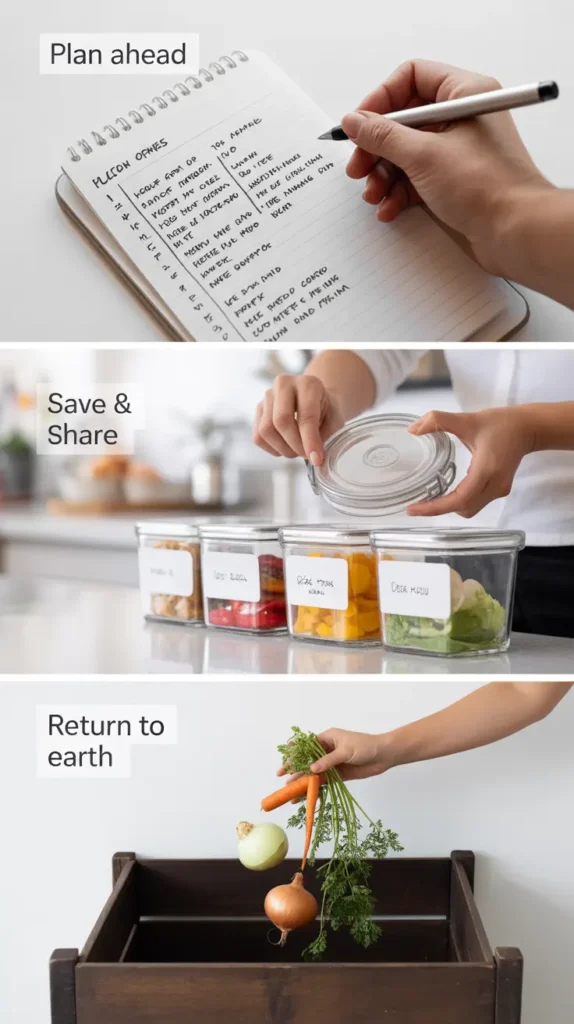
During preparation, implement these waste-reducing techniques: Collect onion skins, carrot tops, celery ends, and herb stems in a container in the freezer to make stock later. Incorporate parts often discarded, like broccoli stems, cauliflower leaves, or bread ends. Use measuring cups and spoons rather than estimating to avoid excess ingredients. If you have excess ingredients during prep, immediately incorporate them into another dish or freeze them for future use. Culinary waste reduction specialists recommend creating a “secondary mise en place” system where trimmings and excess ingredients are organized according to potential uses rather than being automatically discarded. This practice, common in professional kitchens, can reduce prep waste by up to 40% while creating resources for future dishes.
How you serve your meal affects how much is consumed versus wasted. Use medium-sized serving dishes and refill as needed rather than putting all of each dish out at once, which can lead to the perception that food left on serving platters is “used.” Provide serving spoons that encourage appropriate portion sizes. Consider serving the meal in courses rather than all at once, allowing guests to gauge their hunger more accurately. And set up a dedicated area with containers and labels for guests to package leftovers before leaving. Food psychology research shows that people take smaller initial portions when serving vessels are smaller, but feel comfortable returning for seconds, ultimately resulting in less waste than when large platters encourage taking more food than needed at once.
Food Waste Hierarchy
1️⃣ Reduce
Plan appropriate portions and shop with a precise list to avoid excess
2️⃣ Reuse
Transform leftovers into new meals and share excess with guests
3️⃣ Recycle
Compost any truly inedible food scraps to return nutrients to the soil
After your celebration, continue your waste reduction efforts. Promptly refrigerate leftovers (within two hours of serving) in shallow containers for quick cooling. Freeze portions you won’t consume within 3-4 days in clearly labeled containers with dates. Use our creative leftover strategies to transform remaining food into exciting new dishes. For truly inedible scraps like bones and certain vegetable parts, composting returns nutrients to the soil rather than sending them to landfills where they produce methane. Food safety experts emphasize that proper storage is critical not just for preventing waste but for ensuring safety. They recommend dividing large quantities of leftovers into smaller containers no more than 2 inches deep, which allows for rapid cooling and prevents the growth of harmful bacteria that can lead to both illness and food waste.
Our Cheesy Winter Green Stuffing with Kale recipe serves 4 people with precisely measured ingredients, helping you avoid excess while creating a memorable side dish. The recipe is also designed to scale up or down easily, allowing you to prepare exactly the amount needed for your gathering without complex recalculations that might lead to errors and waste.
Community-Focused Celebrations: Sharing the Sustainable Spirit
A truly sustainable Thanksgiving extends beyond environmental considerations to embrace social sustainability through community connection. By incorporating community-minded practices into your celebration, you create not just a memorable meal but a meaningful experience that nurtures relationships and shared values. After all, the original Thanksgiving was about community coming together, right? Anthropologists studying the social functions of communal meals across cultures note that shared food experiences create bonds that extend beyond the meal itself, building social capital that strengthens communities in times of both celebration and challenge.
Consider these approaches to make your Thanksgiving more community-centered: Invite guests to contribute dishes, reducing the resource burden on a single household and allowing everyone to share their specialties. Ask participants to bring recipe cards for their contributions, creating a collection of sustainable Thanksgiving ideas to share. Invite guests to arrive early to participate in meal preparation, sharing cooking techniques and creating memories through collaborative creation. Some of my favorite Thanksgiving memories are from helping in the kitchen, not just sitting at the table! Social psychologists have documented that collaborative food preparation creates stronger interpersonal connections than simply eating together, as the shared task creates a sense of common purpose and achievement that enhances the subsequent eating experience.
“The most sustainable celebrations are those that nourish not just our bodies, but our connections to each other and to the traditions that give our lives meaning.” — From our sustainable celebrations philosophy at Whaley Cooks
Incorporate gratitude and giving into your celebration. Set aside a portion of your grocery budget to purchase items for local food banks, which are often in high demand during the holiday season. Arrange for your gathering to volunteer at a community meal before your own celebration. Invite guests to contribute to a relevant environmental or community organization as part of your gathering. Did you know that approximately 10% of US households are food insecure? The average family’s Thanksgiving food waste could feed people in need for an entire weekend. Food security advocates note that holiday food drives are most effective when they focus on nutritious, versatile staples rather than traditional holiday items, which are often donated in excess while other necessities remain in short supply.
Create a welcoming atmosphere that honors diverse perspectives. Offer abundant plant-based options like our Cheesy Winter Green Stuffing with Kale that accommodate various dietary needs while remaining delicious for everyone. Take time to learn about and acknowledge the complex history of Thanksgiving, including indigenous perspectives. Create space for guests to share their own cultural food traditions, potentially incorporating diverse dishes that represent your community’s unique composition. Cultural historians emphasize that acknowledging the complex origins of Thanksgiving doesn’t diminish the celebration but rather enriches it by connecting personal gratitude practices to broader historical awareness, creating a more thoughtful and inclusive experience.
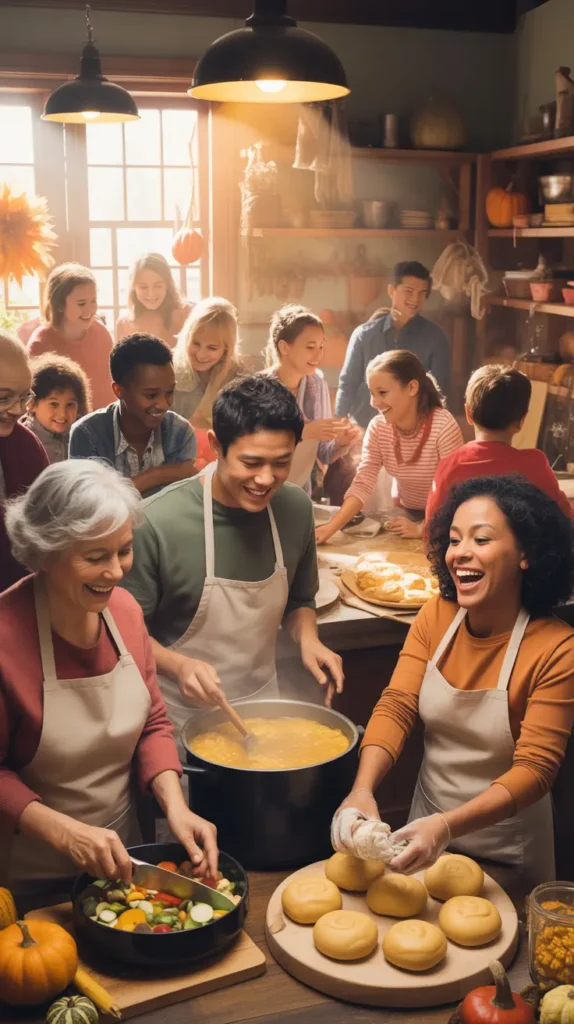
For those who cannot gather in person, consider these sustainable approaches to digital celebration: Arrange to prepare the same recipes simultaneously while connected via video call. Create a digital cookbook with contributions from everyone who would normally attend your gathering. Coordinate with distant loved ones to celebrate on different days, allowing you to join their gatherings virtually without trying to participate in multiple events on the same day. Digital communication experts recommend planning virtual gatherings with specific shared activities rather than open-ended video calls, creating more engaging and memorable experiences that mimic the structured nature of in-person celebrations.
Our collection of vegetarian appetizers offers perfect options for community gatherings, with recipes designed to please diverse palates while remaining environmentally conscious. These shareable dishes encourage conversation and connection, supporting the community-building aspect of sustainable celebrations.

